The Poppy, Remembrance & Welfare Fund Raising

|
From its association with poppies flowering on the First World War battlefields of Belgium, France and Gallipoli this vivid red flower has become synonymous for many people with remembering the loss of life and destruction in the Great War of 1914-1918.
- Colour and Life in a Devastated Landscape
- Campaigns for the Poppy as a Fund Raiser
- 1920: USA, American Legion Adopts the Memorial Poppy
- 1921: Canada, National Flower of Remembrance
- 1921: Britain, First British Legion Poppy Day Appeal
- 1921: Australia, Memorial Poppy on Armistice Day
- 1922: New Zealand, First Poppy Day
- The White Poppy
Colour and Life in a Devastated Landscape
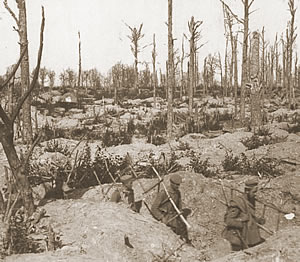
|
In the fighting zones the devastation caused to the landscape over a period of years while in a state of static warfare created a wasteland of churned up soil, smashed up woods, fields and streams. Few elements of the natural world could survive except for the soldiers who had little choice but to live in an underground network of holes, tunnels and trenches. In many cases the only living things they might see on the ground during tours of duty in front line trenches were scavenging rats, mice and lice. Sometimes, however, the sounds of nature could be heard through the fog of battle. Soldiers' accounts write of how birds, and most particularly larks, could be heard twittering high in the sky even during the fury of an artillery bombardment.
James McConnell was an American pilot who had volunteered to fight in the war and was flying with the French Escadrille Lafayette. He recorded a vivid description of the destroyed landscape below him as he flew over the 1916 battlefield of Verdun. He describes the front line as a “brown belt, a strip of murdered Nature”:
“Immediately east and north of Verdun there lies a broad, brown band ... Peaceful fields and farms and villages adorned that landscape a few months ago - when there was no Battle of Verdun. Now there is only that sinister brown belt, a strip of murdered Nature. It seems to belong to another world. Every sign of humanity has been swept away. The woods and roads have vanished like chalk wiped from a blackboard; of the villages nothing remains but gray smears where stone walls have tumbled together... On the brown band the indentations are so closely interlocked that they blend into a confused mass of troubled earth. Of the trenches only broken, half-obliterated links are visible.” (2)
New Life on the Battlefields

|
Against the odds, new life did also occasionally come into being in the battle zones. A story about the birth of new human life happened during the surprise gas attack on the French lines by the German Army on 22 April 1915. At exactly 5 o'clock, as the gas cloud was released, a Belgian woman gave birth to a baby boy in the cellar of a cottage on the Zonnebeekseweg, just 3 kilometres from the poisonous gas cloud and the battle that was going on as a result of it. The next day the mother fled the battle area with her newborn child. She managed to meet up with her husband in England. In 1920 the Lauwers family returned to Ypres. The child's birth certificate for 5 o'clock on 22 April 1915 was reissued in 1920.(3)
The spring of 1915 was the first time that warm weather began to warm up the countryside after the cold winter at war in 1914-1915. In the region around Ypres in Belgian Flanders the months of April and May 1915 were unusually warm. Farmers were ploughing their fields close up to the front lines and new life was starting to grow. One of the plants that began to grow in clusters on and around the battle zones was the red field or corn poppy (it's species name is: papaver rhoeas). It is often to be found in or on the edges of fields where grain is grown.
The field poppy is an annual plant which flowers each year between about May and August. It's seeds are disseminated on the wind and can lie dormant in the ground for many years. If the ground is disturbed from the early spring the seeds will often germinate and the poppy flowers will grow.
This is what happened in parts of the front lines in Belgium and France. Once the ground was disturbed by the fighting, the poppy seeds lying in the ground began to germinate and grow during the warm weather in the spring and summer months. The field poppy was also blooming in parts of the Turkish battlefields on the Gallipoli penninsular when the ANZAC and British Forces arrived at the start of the campaign in April 1915.
“In Flanders Fields the Poppies Blow ...”

|
In May 1915 the sight of these delicate, vibrant red flowers growing on the shattered ground caught the attention of a Canadian soldier by the name of Major John McCrae. He noticed how they had sprung up in the disturbed ground of the burials around the artillery position he was in. It is believed that he composed the poem “In Flanders Fields” at that time. The first verse of the poem has become four of the most famous lines written in relation to the First World War:
In Flanders fields the poppies blow
Between the crosses, row on row,
That mark our place; and in the sky
The larks, still bravely singing, fly
Scarce heard amid the guns below.
“In Flanders Fields” poem by John McCrae
Poppies on the Old Battlefields
Nowadays poppies still flower on the old 1914-1918 battlefields of northern France and Belgium. Due to the nature of farming today the poppies blooming in the battlefield areas tend to be found in small clusters on the edges of fields and roads.
Campaigns for the Poppy as a Fund Raiser
During and after the war the poppy and its connection with the memory of those who died in that war was expanded to help the military and civilian survivors of that war. Two inspirational and dedicated women, French lecturer Anna A Guérin and American teacher Moina Michael, campaigned over many years with their supporters for this symbolic red flower to be a means for raising funds for those suffering as a result of the war, most especially returning Servicemen and women, orphaned children and those who were displaced in the devastated regions.
Madame Anna Guérin, the Poppy Lady from France
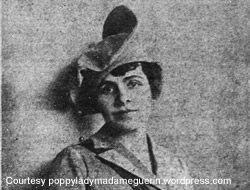
|
Madame Guérin was a well-known touring lecturer and fundraiser, who split her time between living in the USA and France during the First World War. She was a director of the “American and French Children's League”, which was the US branch of the French charity “ La Ligue des enfants de France et d’Amérique” founded in November or December 1918. The emblem chosen for the charity was a poppy. The charity assisted French women, children and war veterans to make artificial poppies out of cloth so that they could be sold and the proceeds would help fund the restoration of the devastated regions of France.
In 1921 Madame Guérin made arrangements for the “American and French Childrens' League” to make the first nationwide distribution across America of the poppies made in France. The funds raised from this venture went directly to the League to help orphaned children and the rehabilitation and resettlement of the areas of France devastated by the First World War. Millions of these French-made artificial poppies were distributed in America by the League between 1920 and 1924.
Anna was determined to introduce the idea of the memorial poppy to the nations which had been Allied with France during the First World War. In the early 1920s she made visits herself and sent representatives to Australia, Britain, Canada and New Zealand.
An excellent website launched in 2015 is devoted to the life and work of Anna Guérin. It is a fascinating piece of research into her personality, her energy and dedication, and her tireless campaigning to raise funds for the war-torn regions of France using the poppy. The in-depth research has been carried out by Heather Johnson, who provides a fresh insight into previously unknown facts about the major part played by Madame Anna Guérin in the story of the poppy and how it has helped to raise funds for people affected by war.
A new book by Heather Johnson (publication 30 October 2022) called The Poppy Lady: The Story of Madame Anna Guérin and the Remembrance Poppy
You can also visit Heather's website to find out more about Anna:
Website: poppyladymadameguerin.wordpress.com
Moina Michael
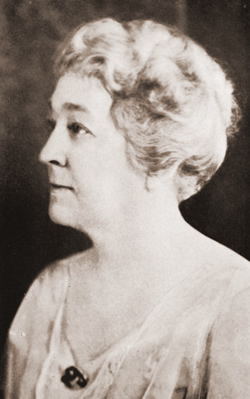
|
Moina was an American teacher working for the YMCA Overseas Secretariat in New York in autumn 1918. On 9 November Moina had a moment of inspiration when she happened upon a magazine illustration accompanying John McCrae's poem “In Flanders Fields the Poppies blow...”. She made a vow to herself to always wear a red poppy in memory of those who had fallen in the war. From that moment on. She was determined to put all her energy into getting the red poppy adopted in the United States as a national memorial symbol.
See our page about Moina and her vision for the Flanders Fields Memorial Poppy:
Moina Michael and the Flanders Fields Memorial Poppy
1920: USA, The American Legion Adopts the Memorial Poppy
The American Legion was founded by veterans of the United States armed forces in 1919 as an organization to support those who had served in wartime in Europe during the First World War.
In August 1920 Moina Michael discovered that the Georgia Department of the American Legion, in her home State, was to convene on 20 August in Atlanta. Prior to the convention she searched out the delegates and the Navy representative promised to present her case for the Memorial Poppy to the convention.
The Georgia Convention subsequently adopted the Memorial Poppy. The Convention also agreed to endorse the movement to have the poppy adopted by the National American Legion and resolved to urge each member of the American Legion in Georgia to wear a red poppy annually on 11 November.
One month later, on 29 September 1920, the National American Legion held its convention. Anna Guérin gave a speech at the event about her idea for an Inter-Allied Poppy Day. The American Legion agreed on the use of the Flanders Fields Memorial Poppy as the United States' national emblem of Remembrance.
In May 1921 the American Legion and the Auxiliary to the American Legion gave their support to a Poppy Day organised by Anna Guérin and the “American and French Childrens' League” charity.
Since May 2017 the Friday before Memorial Day in the USA Congress has been designated a National Poppy Day.
The American Legion
Find out more about the history of the poppy and the American Legion, and how you can support the organization:
Website: www.legion.org History
Website: www.legion.org
The Buddy Poppy Program
In 1922 the “American and French Childrens' League” charity was disbanded but Madame Anna Guérin was still keen to raise funds in the USA for the French people who had suffered the destruction of their communities. She asked the American organization called Veterans of Foreign Wars (VFW) to help her with the distribution of her French-made poppies throughout the United States.
That year the VFW assisted with the sale of the poppies in America to help keep up the much needed funds for the battle-scarred areas of France. The poppies were sold before Memorial Day which was observed at that time on 30 May. This was the first time that a United States war veterans' organization took on the task of selling the red poppy throughout the USA as a symbol of Remembrance and as a means of fund raising. The VFW decided to adopt the poppy as its own official memorial flower.
Following the distribution of the red French-made poppies for Madame Guérin in 1922, the Veterans of Foreign Wars (VFW) formally agreed in 1923 that American veterans of the Great War could also benefit from making and selling the red Memorial Poppy.
From 1924 disabled ex-servicemen started making poppies at the “Buddy Poppy” factory in Pittsburgh. The name “Buddy Poppy” was registered as a U.S. Patent in February 1924. In the following May a certificate was issued to grant trademark rights to the VWF for the manufacture of the genuine “Buddy Poppy”.
Since the 1920s the “Buddy Poppy” program has continued to raise money for the welfare and support of veterans and their dependants. There are now 11 locations where the “Buddy Poppy” is made by disabled and needy veterans. Some 14 million “Buddy Poppies” are distributed each year in the United States.
To find out more about the “Buddy Poppy” and how you can support the work of this organization visit:
Website: www.vfw.org Buddy Poppy
Website: www.vfw.org
American Legion Auxiliary Poppy Program
The Auxiliary to the American Legion was an organization founded in 1919 to support The American Legion. It was for women who wanted to devote their voluntary services to veterans and young people. The first convention of the Auxiliary took place in September 1921 and delegates agreed to adopt the red poppy as the memorial flower for the organization.
The delegates at the convention also agreed that disabled American war veterans could make their own poppies to be sold within the United States. The Auxiliary believed that US veterans making their own poppies could generate much needed income for disabled and unemployed veterans who had no other means of earning money. The Auxiliary provided all the material for the artificial poppies and had it pre-cut to form easily into individual flowers. The Auxiliary paid a penny for each poppy that was made.
Moina Michael was very pleased with this development. According to her there was a feeling in America that so many returning servicemen did not have jobs and that they could themselves benefit from making and selling poppies. These men had done their bit for France and now they needed to provide food, shelter and clothing for their own families.(5)
The American Legion Auxiliary continues its work to support veterans and promotes the wearing of a red poppy on the annual National Poppy Day and Memorial Day observed in May in the United States. Paper poppies are handmade by veterans who are paid for them.
Find out more about the American Legion Auxiliary Poppy Program:
Website: www.alaforveterans.org Poppy
1921: Canada, National Flower of Remembrance

|
Madame Anna Guérin travelled to Canada, where she met with representatives of the Great War Veterans Association of Canada. This organization later became the Royal Canadian Legion. The Great War Veterans Association adopted the poppy as its national flower of Remembrance on 5 July 1921.
From 1922 disabled Canadian war veterans made the lapel poppies that were sold in Canada. This was carried out with sponsorship from the Canadian government Department of Soldiers Civil Re-establishment. From 1966 the operation was moved to the workshops of the Veterans' Affairs Canada, called Vetcraft, in Montreal.
More recently the Royal Canadian Legion has taken over the task of producing the poppies for Remembrance Day. The poppies are now made by a company under the guidelines of the Royal Canadian Legion.
Royal Canadian Legion
Find out more about the work of the Royal Canadian Legion and how you can support its good work:
Website: www.legion.ca
1921: Britain, First British Legion Poppy Day Appeal

|
In August 1921, a few weeks after the formation of the British Legion (May 1921), Madame Anna Guérin travelled from Canada to London for a meeting at the British Legion headquarters. She explained her idea for the public sale of artificial red poppies to raise money for veterans' needs with a percentage of funds to go to her own cause of supporting the children in the Devastated Areas in France. The idea was accepted by the British Legion for the forthcoming third commemoration of the Armistice on 11 November. 1 million artificial poppies were ordered from firms in France as recommended by Anna.(6)
This was the first introduction to the British people of the idea of a Memorial Poppy. The first British Poppy Day Appeal was launched in the run up to 11 November 1921.
Since that time the British public has donated to the annual Poppy Appeal to raise funds in support of the organization's charitable work. The British Legion was granted a Royal Charter on 29 May 1971 and has been named The Royal British Legion from that time.
Royal British Legion

|
To find out information about The Royal British Legion, the work that it does and how you can support the charity visit the website at:
Website: www.britishlegion.org.uk
Order a Poppy Wreath
Visit the Royal British Legion website to find out how to order a wide range of wreaths in exchange for a donation:
Website: www.britishlegion.org.uk Wreaths
The Poppy Factory, Richmond, England
In 1922 the Poppy Factory was established in the Old Kent Road in south London. It was the idea of Major George Howson MC, founder of The Disabled Society for disabled ex-servicemen and women. By making artificial poppies for sale around the anniversary of the 1918 Armistice, the Poppy Factory could employ disabled men throughout the year.
In 1933 the demand for poppies for Poppy Day was such that the Poppy Factory had to move to larger premises in Richmond, Surrey. The demand for poppies has continued to grow each year.
Nowadays the Poppy Factory is producing nearly 40 million poppies for wreaths, sprays and buttonholes.
To find out more about the Poppy Factory visit:
Website: www.poppyfactory.org
The Lady Haig Poppy Factory, Scotland
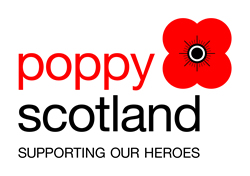
The Earl Haig Fund Scotland was set up as a Scottish charity in 1921 by its founder Field Marshal Earl Douglas Haig. In 1926 Countess Dorothy Haig, wife of Earl Haig, founded the Poppy Factory in Edinburgh. Earl Haig had been born in Edinburgh.
The charity now trades by the name of Poppyscotland, based in Edinburgh. It continues to raise funds for the Scottish Poppy Appeal, supporting veterans and their dependants in Scotland. The Lady Haig Poppy Factory produces over four million poppies each year. Approximately 30 veterans with disabilities are employed at the Factory.
Find out about the Poppyscotland Poppy Appeal:
Website: www.poppyscotland.org.uk
1921: Australia, Memorial Poppy on Armistice Day
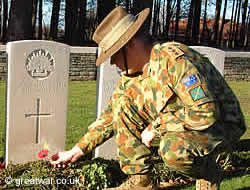
|
A resolution was passed in Australia that from 11 November 1921 the red Memorial Poppy was to be worn on Armistice Day in Australia.
The “American and French Childrens' League” sent a million artificial poppies to Australia for the 1921 Armistice Day commemoration. The Returned Soldiers and Sailors Imperial League sold poppies before 11 November. A poppy was sold for one shilling each. Of this, five pennies were donated to a French childrens' charity, six pennies were donated to the Returned Soldiers and Sailors Imperial League and one penny was received by the government.
Since that time red poppies have been worn on the anniversary of Armistice in Australia, officially named Remembrance Day since 1977. Poppy wreaths are also laid in Australia on the day of national commemoration called ANZAC DaY on 25 April. This is the day when the ANZAC Force landed on the beaches of the Gallipoli penninsular at the start of that campaign on 25 April 1915.
Returned Services League (Australia)
Find out more about today's organization and how you can support it:
Website: rslnational.org
1922: New Zealand, First Poppy Day
In September 1921 a representative of Madame Anna Guérin visited the New Zealand veterans' association, called the New Zealand Returned and Services Association (NZRSA). This organization had been established in 1916 by returning wounded veterans.
With the aim of distributing poppies in advance of the anniversary of Armistice Day on 11 November that year, the NZRSA placed an order for 350,000 small and 16,000 large French-made poppies from the “French and American Childrens' League”. Unfortunately the delivery of the poppies did not arrive in time to organize and publicize the first nationwide poppy campaign, the Association decided to hold the first Poppy Day on 24 April, the day before ANZAC Day, in the following year.
The first Poppy Day in New Zealand in 1922 raised funds of over £13,000. A proportion of this was sent to the “French and American Childrens' League” and the remainder was used by the Association for support and welfare of returned servicemen in New Zealand.
The poppies for Poppy Day distributed by the NZRSA were obtained from the “French Childrens' League” in France until 1927. For the next three years they were ordered from the Poppy Factory in Richmond, England. It was in 1931 that the NZRSA established a scheme in Auckland and Christchurch so that disabled veterans could make the poppies themselves. At the end of the Second World War the number of poppies distributed in New Zealand had grown to approximately 750,000.(7)
The design of the poppy was changed in 1978 to that of the “Earl Haig poppy” as produced by the Royal British Legion. The Christchurch RSA is now responsible for the production of all the poppies made for Poppy Day in New Zealand.
Royal New Zealand Returned and Services Association (RNZRSA)
Find out more about today's organization and how you can support it:
Website: www.rsa.org.nz
The White Poppy
White Poppies are distributed by the Peace Pledge Union for those who wish to wear one. The White Poppy was first distributed by the Peace Pledge Union in 1934. The organization represents the remembrance of all victims of war, a commitment to peace and challenges the glamorization or celebration of war.
Website: ppu.org.uk Remembrance White Poppies
Related Topics
“In Flanders Fields” poem by John McCrae
Related Reading
The Poppy Lady: The Story of Madame Anna Guérin and the Remembrance Poppy
by Heather Johnson
Acknowledgements
(1) Private collection. Photograph by kind permission of the late Bridgeen Fox.
(2) Quoted from James McConnell, Flying for France, New York, 1916. McConnell was killed in March 1917 when he was shot down.
(3) Source: Dokumentatiecentrum, In Flanders Fields Museum, Ieper.
(4) Photograph of Moina Michael in“The Miracle Flower”, reproduced by courtesy of Dorrance Publishing Co. Inc.
(5) The Miracle Flower, page 81.
(6) Chapter 7d: The Empire: Great Britain: Poppy
Website poppyladymadameguerin.wordpress.com Chapter 7d
(7) The History of the RSA Poppy Appeal. An article on the RSA website:
Website: www.rsa.org.nz History RSA Poppy Appeal
Madame Anna Guérin
Very grateful thanks to Heather Johnson and her research dedicated to Madame Anna Guérin:
Website: poppyladymadameguerin.wordpress.com